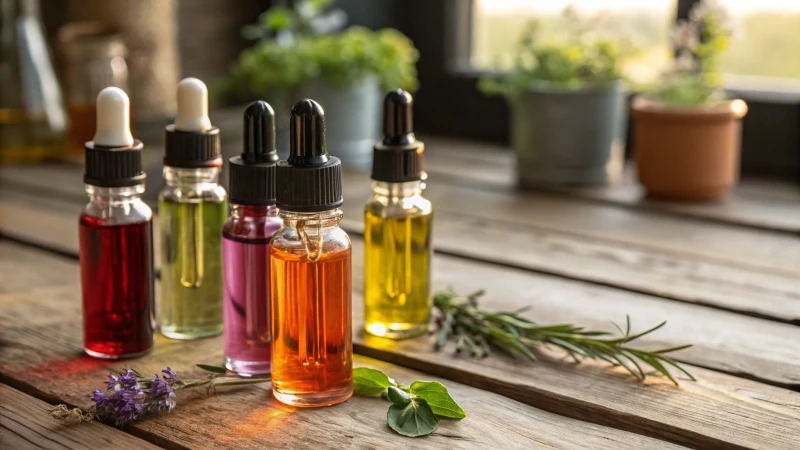
Ever wondered why glass dropper bottles are the go-to for essential oils?
Glass dropper bottles are favored for essential oils because they ensure chemical stability, safeguard against UV rays, and maintain the oils’ therapeutic properties. They also offer a luxurious appearance, adhere to regulations, and support eco-friendly initiatives, making them perfect for storage and customer satisfaction.
I remember the first time I decided to dive into the world of essential oils. It was like opening a door to a secret garden of aromas and therapeutic wonders. But what I quickly realized was that preserving these precious oils was just as important as selecting them. That’s where glass dropper bottles come in. They not only protect the integrity of the oils but also add an elegant touch to the whole experience. Unlike plastic, which can sometimes play nasty tricks by interacting with the potent oils, glass stays loyal and true, keeping everything just as it should be. It’s like having a reliable friend who always has your back. Plus, those amber or cobalt blue bottles look stunning on my shelf, catching just enough light to sparkle without risking the oil’s quality. It’s these thoughtful touches that make all the difference in ensuring both the longevity and efficacy of my little aromatic treasures.
Glass bottles protect essential oils from UV damage.Echt
Glass provides UV protection, preserving essential oil quality.
Plastic bottles are more eco-friendly than glass for oils.Vals
Glass is more sustainable and recyclable than plastic.
Why is glass the best choice for storing essential oils?
Have you ever wondered why glass is the go-to choice for bottling essential oils? It’s all about keeping those precious oils as pure as they should be.
Glass is chemically stable for essential oils because it doesn’t react with the powerful compounds in the oils, ensuring their purity and effectiveness over time.
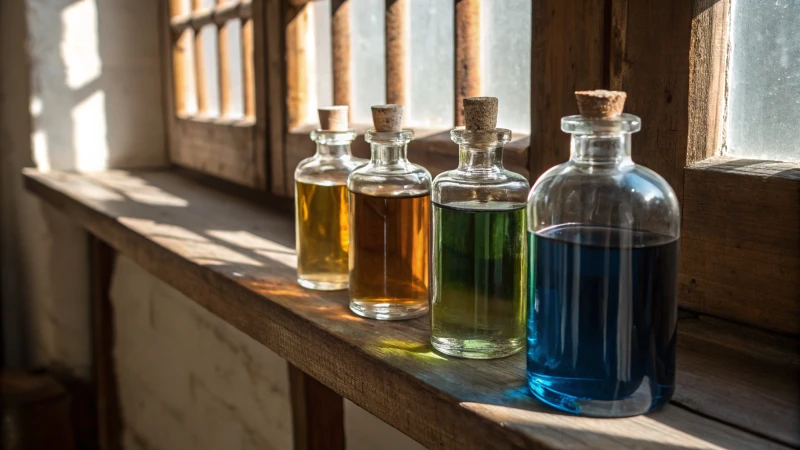
Chemical Inertness of Glass
I remember when I first started exploring essential oils, I was fascinated by their potency and purity. It was a revelation to learn that glass plays a crucial role in preserving these qualities. Glass’s chemical inertness means it doesn’t react with other substances. Essential oils, known for their strong solvents, can easily degrade or leach chemicals from other materials like plastic. Using glass containers1 keeps the oils pure and untainted, just as nature intended.
Types of Glass Used
Over time, I’ve discovered that not all glass is created equal. Different types offer varying levels of stability. Borosilicate glass, for example, is renowned for its ability to withstand thermal shock, making it a favorite for storing essential oils. It’s particularly effective at handling the volatile compounds2 that many oils contain.
| Type of Glass | Key Characteristics |
|---|---|
| Borosilicate | Heat-resistant, chemically inert |
| Soda-Lime | Economical, moderate chemical inertness |
| Amber Glass | UV protection, aesthetic appeal |
Impact of Glass Composition
The composition of glass greatly influences its stability. For instance, traditional soda-lime glass includes silica, soda ash, and lime, which offer basic resistance. However, for more reactive essential oils, borosilicate or specially treated amber glass3 is often preferred.
Advantages Over Other Materials
I’ve seen firsthand how plastic and metal can fail with essential oils. Plastics might leach harmful substances, and metals could react with the oils’ compounds, affecting their efficacy. Glass remains a non-reactive alternative.
Glass and Light Sensitivity
Essential oils are sensitive to light, which can degrade them over time. I’ve found amber glass particularly useful because it filters out harmful UV rays. Some brands even enhance this with dual-coating technologies for additional light protection4, combining functionality with clear aesthetics.
Understanding these benefits highlights why glass is often the preferred choice for packaging essential oils.
Glass does not react with essential oils.Echt
Glass's inert nature prevents chemical reactions with essential oils.
Plastic containers are ideal for essential oils.Vals
Plastics can leach chemicals into oils, unlike stable glass.
How Does UV Protection Enhance Oil Potency?
Ever wondered how a simple glass bottle could be the secret to keeping your essential oils potent and effective?
UV protection boosts oil potency by preventing oxidation, which degrades essential oils. Using UV-blocking packaging, like amber or cobalt blue glass bottles, maintains their therapeutic properties by filtering out harmful rays.
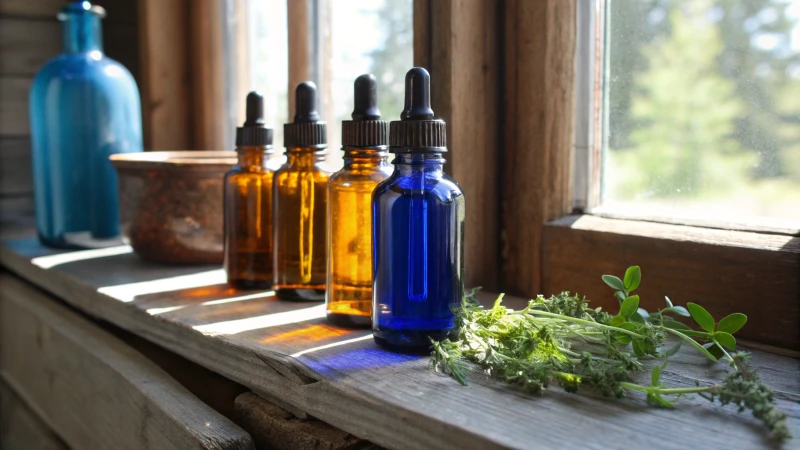
The Science Behind UV Damage
I remember the first time I learned about UV rays in a way that really hit home. I was visiting a lavender farm, marveling at the endless rows of purple blooms. The farm owner shared how sunlight—while wonderful for growing plants—can be detrimental to the essential oils extracted from them. Those UV rays can sneakily cause oxidation, altering the oils’ composition and diminishing their fragrance and healing powers. That’s when I realized just how critical it is to protect these precious liquids from sunlight.
Benefits of UV-Protected Packaging
Enhanced Longevity: I often compare amber glass bottles5 to a superhero cape for oils—they might look simple, but they have the power to block up to 97% of UV rays, keeping the oil’s essence intact. Whether it’s lavender or eucalyptus, you want those scents to remain as fresh as the day you bottled them.
| Glass Type | UV Blocking Ability |
|---|---|
| Amber | Up to 97% |
| Cobalt Blue | Around 60% |
Industry Practices and Innovations
The more I delve into packaging trends, the more I appreciate innovation. Some brands are now using dual-coating technologies that marry aesthetics with protection. Imagine a bottle that’s not just functional but also a piece of art on your shelf.
Market Appeal and Sustainability
In my journey with Beautipak, I’ve seen how eco-consciousness has become more than just a trend—it’s a lifestyle choice for many. Glass packaging hits the sweet spot by being both recyclable and protective. It’s a win-win that resonates with consumers and boosts brand image.
Practical Considerations
When I choose packaging for our products, I always weigh both functionality and flair. The right packaging does more than just protect; it tells a story, setting your brand apart in a crowded market.
Consider both the level of UV protection and the visual appeal6 of the product when selecting packaging.
Challenges and Solutions
Sure, glass can be pricier upfront, but in my experience, the payoff comes in less waste and happier customers. It’s an investment in quality that pays dividends in brand loyalty and product excellence.
I’ve learned through trial and error that finding reliable suppliers is key. Ensuring they offer valid certifications7 is crucial to maintaining standards and trust with my customers.
Amber glass blocks up to 97% of UV rays.Echt
Amber glass is known for its high UV blocking ability, filtering most rays.
Cobalt blue glass offers better UV protection than amber.Vals
Cobalt blue blocks around 60% of UV rays, less than amber's 97%.
Why Is Precision Important in Dropper Design?
Ever tried to pour just the right amount of something and ended up with way too much? That’s where precision in dropper design saves the day.
Precision in dropper design is vital for ensuring accurate dosing, crucial for the safety and effectiveness of pharmaceuticals and skincare products. It prevents misuse, improves user experience, and maintains product integrity.
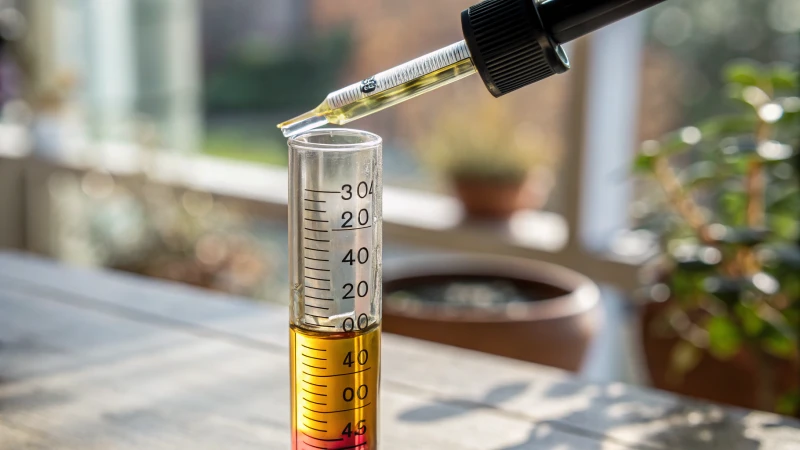
Precision and Product Safety
I remember the first time I was tasked with finding the perfect dropper for our line of essential oils. I thought, how hard could it be? But the reality hit when a client complained about inconsistent dosing affecting their skin treatment. It dawned on me that the tiniest miscalculation could lead to discomfort or ineffective results. A dropper needs to be spot-on with every single use.
In pharmaceutical and cosmetic industries, accurate dosing8 is critical. A dropper that delivers inconsistent amounts can lead to overdosing or underdosing, impacting safety and efficacy. Inconsistent delivery can compromise treatment effectiveness or cause skin irritation.
The Role of Dropper Design
Designing a dropper isn’t just about picking a pretty shape—it’s like engineering a tiny piece of art that needs to perform with precision. I once worked with a team that obsessed over every detail, from the dropper’s diameter to the materials used, ensuring every drop was consistent. It’s an art form, blending science and creativity.
Dropper design involves meticulous engineering to ensure precise fluid delivery. Factors like dropper diameter, material choice, and neck fit play crucial roles in achieving precision. Advanced designs use medical-grade components to ensure precision.
User Experience and Brand Perception
Ever noticed how some luxury brands use those elegant glass droppers? There’s a reason for that. I’ve seen firsthand how a well-crafted dropper can elevate a brand’s image, making the product feel more premium and trustworthy. When users find your product reliable, they stick around.
A well-designed dropper enhances user experience by providing ease of use and reliability. Users trust brands that deliver consistent results. Glass droppers often align with luxury branding due to their aesthetics and perceived quality.
Material Selection: Glass vs. Plastic
Choosing between glass and plastic often feels like choosing between style and practicality. When I was faced with this decision, the eco-friendly aspect of glass had me convinced, despite its higher costs.
| Material | Benefits | Challenges |
|---|---|---|
| Glas | Chemically inert, premium feel | Fragility, higher cost |
| Kunststof | Cost-effective, lightweight | Chemical reactivity, lower perceived value |
Choosing the right material involves balancing cost with user experience and product stability. Eco-friendly packaging9 trends also influence material choices.
Precision in Emerging Markets
In emerging markets, the demand for precision in packaging is skyrocketing. I’ve watched suppliers innovate relentlessly, balancing quality with cost. It’s fascinating how they manage to stay competitive yet meet global standards.
As demand for precision in product packaging grows, emerging markets prioritize high-quality dropper designs. Suppliers in regions like China are innovating to meet these demands while maintaining competitive pricing.
The need for precision is about more than just function—it’s about keeping pace with sustainability trends and meeting consumers’ expectations for quality.
Engineering Challenges and Solutions
Precision engineering is no small feat. I recall a project where we faced leakage issues—turns out it was all about getting the neck fit right. By tweaking our mold designs and using silicone seals, we managed to solve it. It’s a continuous journey of improvement and adaptation.
Precision engineering involves addressing challenges like leakage prevention through precise mold designs and the use of silicone seals. Continuous improvement in design techniques ensures consistent performance across various climates and usage conditions.
Developing precision in dropper design is an ongoing saga of research and innovation constantly evolving to meet global demands.
Glass droppers are more chemically inert than plastic ones.Echt
Glass is less reactive, providing a stable environment for contents.
Plastic droppers are more cost-effective than glass droppers.Echt
Plastic is cheaper to produce, reducing overall manufacturing costs.
How Does Sustainability Influence Packaging Decisions?
Imagine standing in the aisle, choosing products based on their packaging, not just their contents. That’s the power of sustainable packaging.
Sustainable packaging plays a critical role in influencing consumer decisions by minimizing environmental impact with eco-friendly materials, smart designs, and recyclability. It boosts brand reputation and aligns with global eco-conscious movements.
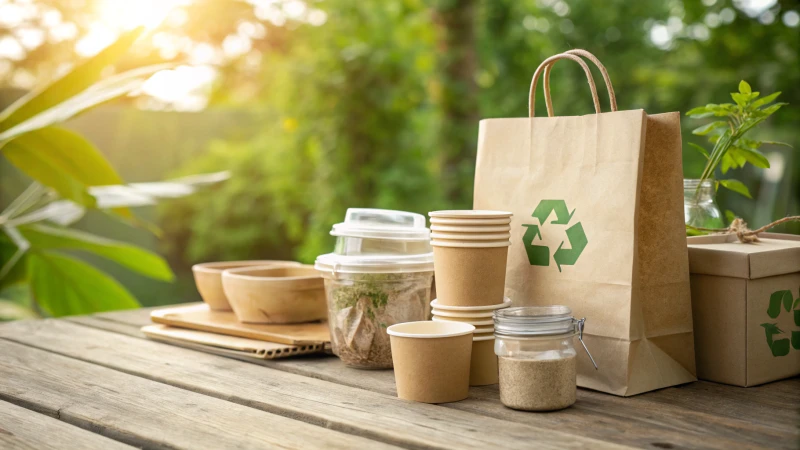
The Environmental Impact of Packaging
When I started exploring sustainable packaging, I was struck by how much traditional materials like plastic affect our planet. They’re everywhere and often end up polluting our beautiful landscapes and oceans. So, switching to more eco-friendly options seemed like a small but impactful step toward reducing waste and pollution.
- Material Choices: I found that opting for materials like cardboard or bioplastics can really help cut down on landfill waste. Plus, they’re biodegradable or recyclable, which feels like a win for the planet.
- Manufacturing Processes: Using energy-efficient methods during production also makes a difference by reducing carbon emissions.
| Material | Biodegradable | Recyclable | Carbon Footprint |
|---|---|---|---|
| Kunststof | No | Yes | High |
| Glas | No | Yes | Moderate |
| Cardboard | Yes | Yes | Low |
Consumer Preferences and Market Trends
It’s fascinating how much consumers, including myself, are drawn to brands that show they care about sustainability. I’ve noticed I’m more loyal to these brands, often willing to pay a bit extra because I know it’s supporting something positive.
- Market Research: Studies back this up, showing a clear trend where people are ready to pay more for sustainable products10.
- Brand Perception: Sustainable packaging doesn’t just appeal to eco-conscious buyers—it also elevates a brand’s image, giving it an edge over competitors.
Innovations in Sustainable Packaging
I’ve seen some pretty cool innovations lately, like edible packaging and reusable containers. These ideas push the envelope on what’s possible, offering creative solutions that reduce environmental footprints.
- Edible Packaging: This concept blew my mind—packaging you can actually eat! It’s made from natural materials, making it safe to consume.
- Reusable Designs: Encouraging reuse extends the lifecycle of the packaging, which is both practical and sustainable.
Regulations and Compliance
In recent years, I’ve noticed more regulations pushing companies towards sustainability. This isn’t just about following the rules; it’s about sparking innovation in the packaging sector.
- Legislative Impact: Laws like the EU’s Single-Use Plastics Directive are steering businesses towards greener alternatives.
- Compliance Benefits: Adhering to these standards can open new markets and reduce legal risks.
Understanding these aspects helps businesses like mine align their packaging strategies11 with both customer expectations and environmental goals. It’s a journey of learning and adapting that I believe will pave the way for a more sustainable future.
Biodegradable packaging reduces landfill waste.Echt
Biodegradable materials break down naturally, minimizing landfill accumulation.
Plastic has a lower carbon footprint than glass.Vals
Plastic generally has a higher carbon footprint due to production emissions.
Conclusie
Glass dropper bottles are preferred for essential oils due to their chemical stability, UV protection, luxurious appearance, and sustainability, ensuring the oils’ potency and enhancing brand value.
-
Discover how the inert nature of glass prevents chemical reactions with stored substances. ↩
-
Learn about the volatile compounds in essential oils and their effects on packaging materials. ↩
-
Explore how amber glass offers superior UV protection for sensitive products. ↩
-
Find out how dual-coating enhances light protection and aesthetic appeal of glass bottles. ↩
-
Learn about how amber glass effectively protects essential oils from UV damage. ↩
-
Explore how UV coatings enhance both protection and aesthetics in oil packaging. ↩
-
Ensure your supplier’s certifications are genuine to maintain product quality and compliance. ↩
-
Understanding accurate dosing is crucial for product safety and effectiveness. It helps prevent adverse effects and ensures optimal therapeutic outcomes. ↩
-
Exploring eco-friendly trends keeps you informed on sustainable practices in packaging, helping align product strategies with consumer preferences. ↩
-
Discover how consumer preferences are shifting towards sustainable products and what this means for brands. ↩
-
Learn about various strategies companies employ to make their packaging more sustainable. ↩



